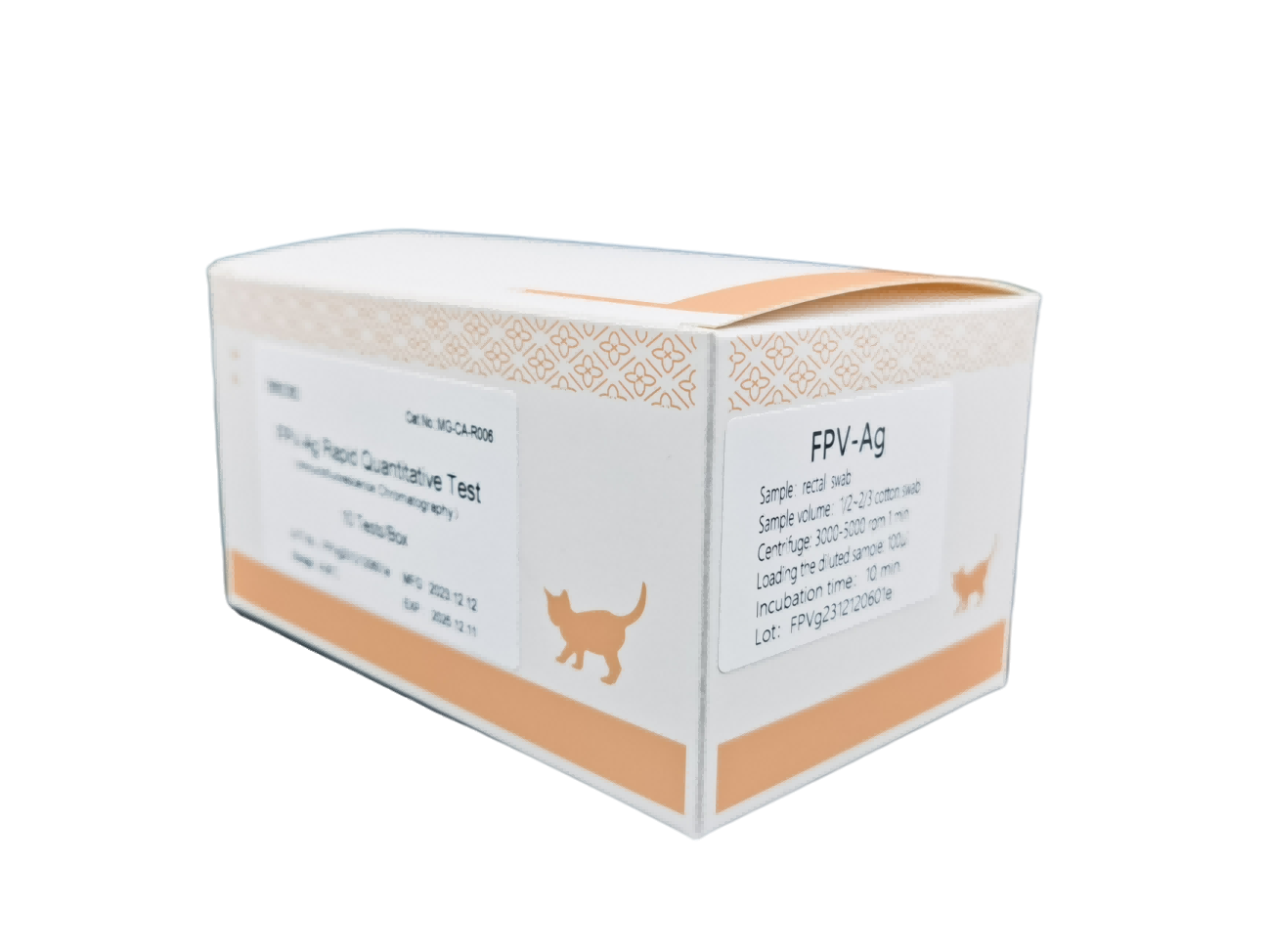



Key attributes

SPECIFICATION
10 Tests/Box
Cat. No.: MG-CA-R008
INTENDED USE
The FCV-Ag test is a fluorescence immunoassay designed for use with an Immunofluorescence Analyzer to quantitatively determine the concentration of herpes virus antigen in feline nasopharyngeal or ocular swabs. This test aids in the diagnosis and monitoring of feline herpes virus infection.
For in vitro diagnostic use only. For professional use only.
TEST PRINCIPLE
This test employs a quantitative double antibody sandwich fluorescence immunoassay technique.
The intensity of the fluorescent signal corresponds to the amount of FCV-Ag captured. The concentration is expressed as Tu/ml.
MATERIALS
Material Provided
Each box contains:
10 individually sealed pouches, each containing:
– A Test Device
– A desiccant pouch
One ID Chip
Instructions for Use
10 cotton swabs
10 tubes of FCV-Ag Sample Buffer
10 Pipette tips
Material Required But Not Provided
Immunofluorescence Analyzer
Timer
Pipette
Centrifuge
STORAGE AND STABILITY
Store the test kit at 4~30℃ until the expiration date.
Operate the test at 18 ~ 28℃ after opening the Test Device.
Perform the test within 30 minutes after opening the pouch.
SPECIMEN COLLECTION AND PREPARATION
The test is performed using a rectal swab.
To collect a rectal sample, insert the swab into the feline’s rectum and rotate it close to the inner wall 3 ~ 5 times. The sample volume should cover about 1/2 ~ 2/3 of the cotton tip.
Perform the test immediately after specimen collection. If testing cannot be done within 3 hours, store the specimen at 2~8℃ for up to 48 hours. For long-term storage, keep the specimen below -20℃.
Bring all materials to room temperature before use. Completely thaw and mix frozen specimens well before testing. Avoid repeated freezing and thawing. Use only clear, non-hemolyzed specimens.
TEST PROCEDURE
Refer to the Immunofluorescence Analyzer Operation Manual for detailed instructions on using the Test Device.
Set the Test Device on a clean, level surface.
Insert the ID Chip into the meter and click "Read ID chip." Ensure that the Test Device lot number matches the ID Chip number.
Place the rectal swab with the sample into the FCV-Ag Sample Buffer. Stir thoroughly and centrifuge for 1 minute (3000 ~ 5000 rpm).
Pipette 100 μl of the mixed sample into the sample well (S) of the Test Device. Avoid forming bubbles.
Choose one of the following test modes:
Standard Test: Click "Standard Test," insert the Test Device into the device holder immediately after adding the sample, and click "Start Test." Select the sample type "Rectal Swab." The meter will automatically count down and display the test result.
Quick Test: Click "Quick Test," start the timer immediately after adding the sample to the sample well, and leave the Test Device at room temperature (18 ~ 28℃) for 10 minutes. Then insert the Test Device into the meter holder and click "Start Test." Select the sample type "Rectal Swab." The instrument will automatically scan the Test Device and display the result.
Results can be viewed on the main screen, printed automatically, or manually by clicking "Print."
QUALITY CONTROL
Each FCV-Ag Rapid Quantitative Test includes an internal control for routine quality control. This internal control is performed each time a patient sample is tested. If an invalid result is obtained from the internal control, the meter will display an error message, indicating the need to conduct another test.
INTERPRETATION
Reference range of FCV-Ag in feline rectal swab.
Detection range: 4.0 ~ 640 Tu/ml
Reference range:
| Result (Tu/ml) | Suggestion |
|---|---|
| ≤ 10 | Negative (-) |
| 10 ~ 14 | Suspected (±) |
| 14 ~ 30 | Weak Positive (+) |
| 30 ~ 150 | Medium Positive (++) |
| > 150 | Strong Positive (+++) |
Each laboratory should establish a reference range that represents the population being evaluated.
WARNINGS AND LIMITATIONS
This kit is for in vitro diagnostic use only.
Inspect packaging and labels before use. Do not use if the pouch is broken, torn, not well sealed, or if the vial appears damaged or leaked.
Do not use the test device beyond its expiration date.
Use a new pipette tip for each specimen.
Technical or procedural errors, as well as additional substances in blood specimens not listed in the instructions, may interfere with the test and cause erroneous results.
